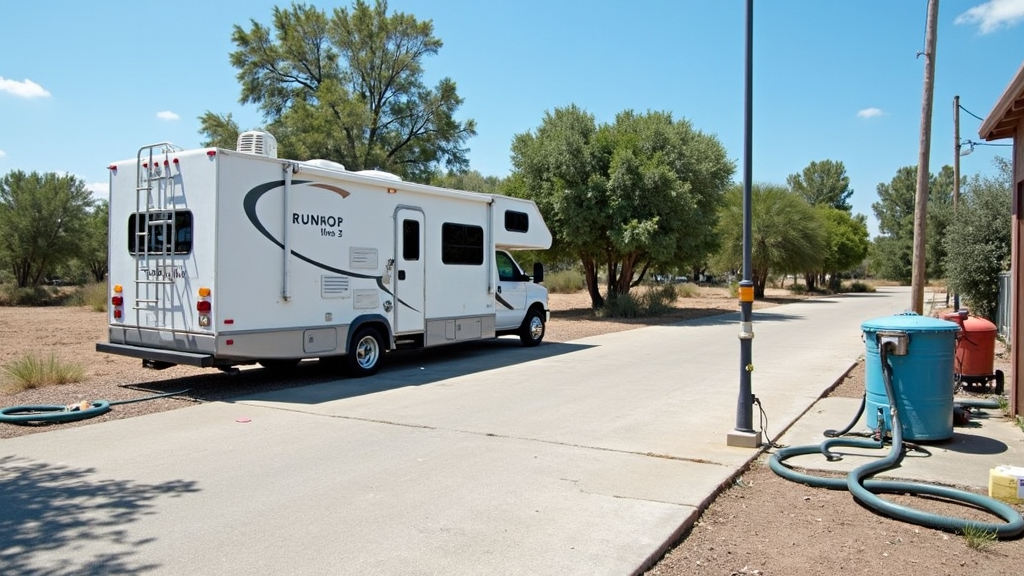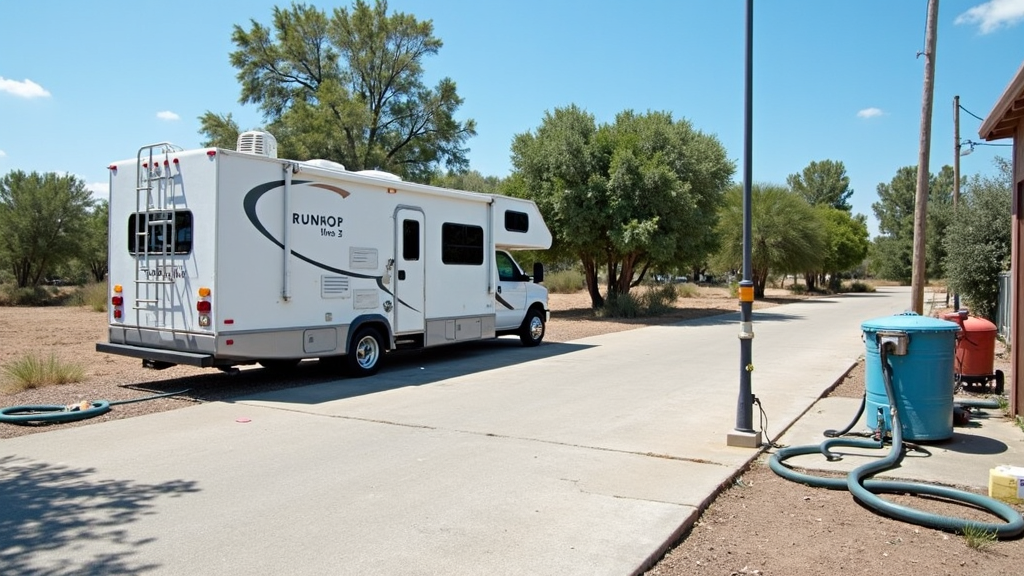RV dumping etiquette matters a lot more than some people realize. Dump stations are shared spaces, and a little care goes a long way in keeping things clean and pleasant for everyone rolling into the site after you. Messes, bad smells, or broken gear can ruin the experience for other campers, and nobody wants that to be their claim to fame at the next campground meetup.
Everyone starts somewhere, and almost every RVer I know has had at least one accidentally messy dump station moment. I’ve been there. One loose hose connection or a missed glove, and your confidence takes a beating. Learning the ropes makes the whole process smoother and less nervewracking each trip.

Table of Contents
- Prepping for a Smooth Stay at the Dump Station
- Step-by-Step Dumping Etiquette for Your RV
- Common Mistakes That Make Dump Stations Gross
- Pro Tips for a Cleaner, Better Dump Experience
- Messy Moments and RV Dumping Nicknames
- How to Be a Good Dump Station Neighbor
- Frequently Asked Questions
- Final Thoughts
Prepping for a Smooth Stay at the Dump Station
Setting yourself up for success starts before you even pull up to the sewer inlet. No one enjoys fixing mistakes with a line of RVers watching, so I like to take my time and do things right from the get-go. Organization and preparation take stress out of the process and help you avoid embarrassing mistakes:
- Line Up Your RV Properly: Make sure your RV’s sewer outlet is on the correct side and lined up close enough so your hose easily reaches without stretching. Misalignment usually leads to awkward hose gymnastics or, even worse, spills.
- Put On Disposable Gloves: Trust me, just do it. Even the most careful dumpers sometimes get an unwelcome surprise. Keep a box of nitrile or latex gloves in your dump kit for peace of mind and better hygiene.
- Double-Check Your Tanks: Make sure both your black and gray tanks are nearly full and ready for dumping. Dumping a half-full gray tank doesn’t do much for cleaning out that hose. Waiting until tanks are full also makes the process more efficient.
- Get Your Equipment Ready: Have your sewer hose, hose fittings, and a clear sewer elbow handy. Setting everything up before stepping outside your RV can save you from a mad scramble for a missing part or getting your clean clothes dirty.
Step-by-Step Dumping Etiquette for Your RV
Clean, hassle-free dumping has a rhythm to it. Once you get the hang of this step-by-step process, things get smoother every time. Take your time, follow the order, and you’ll avoid nearly all common mistakes:
- Connect the Sewer Hose Securely: Always check that your sewer hose is fully attached to your RV and clicked into the dump station inlet. Loose ends are usually how disasters begin. Give everything a little push, then double-check before opening any valves for peace of mind.
- Test Connections: Dump a little great water first to make sure all connections are secure and that there are no leaky hoses or connectors.
- Dump Black Tank First: The black tank holds the “yuck” stuff, so always empty it before the gray. This order helps with hose cleaning later on. Wait until the tank is fully drained; listen for the gurgle or watch the clear elbow to know it’s empty.
- Let It Drain Completely: Never rush this part. Trying to pack up before the water’s done flowing can lead to splashes and messes. I wait for that final gurgle or for the flow to stop completely, and the clear elbow is helpful here for reassurance.
- Dump the Gray Tank Second: Gray water (from showers and sinks) helps flush out whatever is left in your hose from the black tank dump. This rinse gets rid of lingering debris and keeps odors down, making the next step cleaner for you.
- Use Tank Rinsers Sensibly: If you have a tank rinser or flush connection, use it to clean the black tank, but don’t spend 20 minutes or longer if others are waiting. Most experienced RVers rinse enough for a quick clean and finish thoroughly elsewhere if needed.
- Clean Up Immediately: If you drip or spill, don’t just leave it. Bring a dedicated hose to rinse the area off. Everyone appreciates a clean station, and it’s good manners to leave it tidy for the next person using the station.
- Never Use Potable Water Hose: If there’s a separate freshwater spigot, never use it to rinse your sewer hose. Keep drinking water clean and free from any chance of contamination by always using the dedicated rinse hose provided for the dump station.
Common Mistakes That Make Dump Stations Gross
Everyone has seen the horror stories on RV forums or witnessed them in person. Here are a few mistakes that really mess it up for everyone and can lead to a miserable experience for all involved:
- Leaving a Mess: It’s hard to overstate how unpleasant leftover spills or even stray paper towels are. Even just a squirt of gray water can leave a bad impression on the next user and draw unwanted critters.
- Skipping the Rinse: Not bothering to rinse the area or your own hose creates lingering odors and attracts bugs. Always finish the job instead of leaving a sticky situation behind for someone else.
- Not Using a Clear Sewer Elbow: These clear fittings let you know exactly when the tanks are empty, and help you avoid disconnecting too soon. Guessing on timing usually doesn’t end well and can lead to nasty surprises.
- Dumping Gray Tank Too Soon: If your gray tank isn’t at least half full, it won’t flush out the hose well. Waiting for a fuller gray tank makes cleanup much easier, so you don’t have to rinse as much by hand.
- Driving Off Prematurely: It’s embarrassing to see someone driving away with their sewer hose still attached (I’ve heard the thud and yells before). Double-check before pulling away, and save yourself the mess and hassle.
- Hogging the Station: If there’s a line, focus on dumping only. Long rinses and cleaning can wait until after you’ve moved away from the station so you’re not holding up other campers who are waiting their turn.
Pro Tips for a Cleaner, Better Dump Experience
Some habits make dumping easier, tidier, and much less stressful, especially when you’ve got a busy RV park. Here are my go-to moves that make the whole process more pleasant for you and those around you:
- Carry Biodegradable Tank Treatments: These break down waste and reduce odors in your tanks. Using them after every dump makes for a better experience as the days go by and keeps things fresher between stops.
- Use a Hose Support: Hose supports keep your sewer hose angled so everything drains easily. No one wants to shake a heavy hose trying to clear a “poo valley”—use a hose support to make the process smoother, especially on uneven terrain.
- Keep Dump Gear Together: Use a separate plastic storage bin for gloves, fittings, hose, and sanitizer. That way, nothing from your stinky kit ever touches your clean camping gear; organization makes future dumping much less stressful.
- Practice Stealth Dumping: Quiet, fast, tidy, and courteous. You’ll be everyone’s favorite neighbor. Avoid loud conversations on speakerphone or blasting music while dumping out of respect for everyone waiting or nearby.
- Hand Sanitizer By the Door: I keep a small bottle of sanitizer near the RV door. After dumping, it’s the first thing I reach for before touching anything else. This habit helps stop germs before they spread to your living space.
If you frequently move sites or use dump stations on the road, adding an extra set of gloves or disposable wipes to your kit won’t hurt. You never know when you or a fellow RVer might need a helping hand, and being prepared ups your odds of handling unexpected situations calmly.
Messy Moments and RV Dumping Nicknames
Just about every longtime RVer has a story about forgetting to double-check a connection or being surprised by a split hose. Once, I went to dump with tired hands and somehow managed to loosen the elbow adapter halfway through. The smell hits you first, and the pure shame comes second. I now double-check every single time, so I don’t have to relive that moment.
Over the years, I’ve heard plenty of fun nicknames for the sewer hose: “the stinky slinky,” “the brown line,” and “the serpent of sadness.” They make for some laughs in the campground, especially after a successful, mess-free dump. Sharing these little stories actually helps newer RVers open up and ask for advice about awkward topics.
How to Be a Good Dump Station Neighbor
Leaving the dump station cleaner than you found it goes a long way. It only takes an extra minute to rinse down the area, pack away all your gear, and make sure the next RVer doesn’t have to deal with your leftovers. If you see someone struggling—confused, missing a part, or on the verge of a mistake—a friendly offer to help can really make their day and possibly save their shoes.
Dumping waste tanks is just another part of RV life. When you follow the right steps and show care for the next visitor, you make the road a nicer place for everyone. Once the routine clicks, dumping really isn’t a big deal, and you might just make a few friends in the process. By helping each other, the RV community stays positive, even during the less glamorous moments.
Frequently Asked Questions
1. What’s the correct order for dumping RV tanks?
Always dump your black tank first, then your gray tank. The gray water helps rinse out any residue from the black tank through your sewer hose, keeping it cleaner and reducing odors.
2. Do I really need to use disposable gloves at the dump station?
Yes, absolutely. Even if you’re careful, splashes or drips happen. Gloves protect you from germs and make cleanup easier. Keep a box in your dump kit and make them a routine part of the process.
3. Is it okay to rinse my sewer hose with the potable water spigot?
No. Never use the drinking water hose for rinsing your sewer equipment. Most stations have a separate non-potable hose for that purpose. Mixing the two can contaminate clean water supplies.
4. How full should my tanks be before dumping?
For best results, wait until both tanks are at least ¾ full. This provides enough pressure for a thorough flush, especially in the black tank. A half-full gray tank won’t rinse the hose effectively.
5. What’s the biggest etiquette mistake RVers make at dump stations?
Leaving a mess behind—whether it’s spills, trash, or skipping a rinse. It’s a shared space, so always clean up after yourself. Being courteous goes a long way and keeps things pleasant for the next person.
If you found these tips helpful, share this post with a fellow RVer or save it for your next trip! Got a funny or hard-earned dump station story of your own? Drop it in the comments—I’d love to hear it. Let’s keep learning (and laughing) together out there on the road. Safe travels and happy dumping! 💩
Final Thoughts
Dumping your RV tanks might not be glamorous, but it doesn’t have to be stressful or gross. With a little preparation, the right gear, and some good old-fashioned campground courtesy, you’ll breeze through the process without a hitch. Everyone in the RV community benefits when we treat shared spaces with respect, and it really does make life on the road smoother for all of us.
We’ve all had a cringe-worthy dump station moment at some point, but those experiences just make us better teachers for the next RVer coming up behind us. A little kindness, a clean site, and a securely attached sewer hose go a long way.
About the Author
Jim has 3.5 years of experience living and traveling full-time in an RV. From “moochdocking” with family and friends to navigating the financial intricacies of RV life, he shares practical advice rooted in firsthand experience. His goal is to help fellow adventurers embrace the RV lifestyle with confidence and ease.
There are no affiliate links in this post but feel free to read our affiliate disclosure.


Fantastic guide, Jim—every new and seasoned RVer should read this at least once a season!
I remember our first big trip in the RV and pulling up to a dump station with shaky hands and zero confidence. Let’s just say I learned very quickly why you always double-check connections and keep gloves handy.
Since then, I’ve created my own little system—labeled bins for clean and dirty gear, a checklist by the door, and yes, a big stash of hand sanitizer right next to the step.
One thing I’d add for folks still learning: take your time and don’t let the line behind you rush you. Mistakes happen when you try to speed through the process under pressure. I’ve found that most people are patient and totally get it—especially when you’re doing it carefully and cleanly.
And “stinky slinky” made me laugh out loud. Ours has been called “the misery noodle” more than once.
Looking forward to hearing other folks’ lessons learned. Anyone else got a funny nickname or a wild dump station moment to share?
Thank you so much for sharing your story and those great extra tips! I couldn’t agree more—taking your time is so important, even when there’s a line. I love your checklist and bin system; little routines like that really do take the stress (and the mess) out of the job. “Misery noodle” cracked me up! It’s comforting to know we all end up with our own collection of nicknames (and probably a few stories we’ll never forget). I’d love to hear what others call theirs or any wild dump station tales. Thanks again for adding to the conversation and making it even more fun for everyone!
Jim,
Great read!! I was laughing the whole time while reading your article. It’s really a practical and humorous guide aimed at new and experienced RVers ( myself included ) who want to, no, need to master the essential task of dumping their RV waste tanks. You’ve highlighted the importance of what good dump station etiquette is—not just to avoid embarrassment or messes, but to show respect for fellow campers utilizing the same space. New to RV life or possibly transitioning from other types of travel, this guide helps you avoid rookie mistakes like leaks, or contaminating potable water—issues that can quickly ruin your experience or reputation at the campground, especially if you want to go back..
I’ve been trailering since 2011, and yes I’ve had my share of mishaps during my first crack at it – like forgetting to secure the right way before purging.. The article benefits anyone who at some point will be using an RV dump stations by providing clear, step-by-step instructions and easy-to-follow tips. Your quick takeaways such as always – always, wear disposable gloves, dump your black tank first then gray tank second, and for the love of pizza – clean up after yourself, should be carved on the next RV, trailer or pop-up tent trailer making its way to a campsite.. Keeping hand sanitizer at the door definitely helps things stay hygienic. Overall, it’s a must-read for RV users who need to know the ropes on how to be clean, courteous, and confidently prepared—even for life’s messiest moments on the road.
Thank you so much for your kind and thoughtful feedback! I’m glad the humor landed. Sometimes it’s the only way to survive those “character-building” moments at the dump station. Your point about showing respect for fellow campers really hits home; it’s amazing how a little courtesy (and a lot of gloves) can make the experience better for everyone. I appreciate you sharing your own early mishaps. It makes us all feel a little less alone in those rookie blunders. Here’s to many more clean, confident, and drama-free dump station visits for all of us! Safe travels out there.